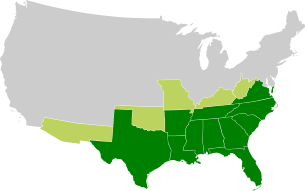Florida in the American Civil War
Florida had joined the Confederacy in advance of the American Civil War, as the third of the original seven states to secede from the Union, following Lincoln's 1860 election. With the smallest population, nearly half of them slaves, Florida sent only 15,000 troops to the Confederate States Army. Its chief importance was in food-supply to the south and support for blockade-runners along its long coastline full of inlets that were hard to patrol.
| State of Florida | |
|---|---|
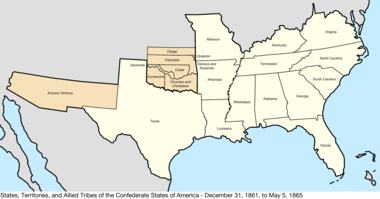 Location of Florida in the Confederate States | |
| Capital | Tallahassee |
| Largest City | Pensacola |
| Admitted to the Confederacy | April 22, 1861 (7th) |
| Population |
|
| Forces supplied |
|
| Major garrisons/armories | Fort Pickens |
| Governor | Madison Perry (1861) John Milton (1861–1865) Abraham Allison (1865) |
| Senators | Augustus Maxwell James Baker |
| Representatives | List |
| Restored to the Union | June 25, 1868 |
| History of Florida |
|---|
 The seal of Florida reflects the state's Native American history |
|
Topics
|
|
Timeline
|
|
|
 |
|
Confederate States in the American Civil War |
|---|
|
|
| Dual governments |
| Territory |
|
Allied tribes in Indian Territory |
At the outbreak of war, the Confederates seized many United States facilities in the state, though the Union retained control of Key West, Fort Jefferson and Fort Pickens throughout the war. There was little fighting in Florida, the only major conflict being the Battle of Olustee, near Lake City in February 1864. However, wartime conditions made it easier for slaves to escape, and many of them became useful informers to Union commanders. As southern morale suffered, deserters from both sides took refuge in Florida, often attacking Confederate units and looting farms. In May 1865, Federal control was re-established, slavery abolished, and the state governor John Milton committed suicide by gunshot.
Background
By 1840 the English in Florida became the majority among people of European descent, rather than Spanish. White Floridians concentrated on developing the territory and gaining statehood. Steamboat navigation was well established on the Apalachicola River and St. Johns River, and railroads were planned.
Slaves
The 1840 population had reached 54,477 people, with African slaves making up almost one-half.[n 1] By 1861, the slave population in Florida had reached 61,000. Their forced labor accounted for 85 percent of the state's cotton production.
Although the Compromise of 1850 was unpopular in Florida, the secession movement in 1851 and 1852 did not gain much traction.[2] A series of events in subsequent years exacerbated divisions.[2]
Senator Stephen Mallory and David Levy Yulee, jointly requested from the War Department a statement of munitions and equipment in Florida forts on January 2, 1860.
1860 U.S. presidential election
Southern Democrats walked out of the 1860 Democratic National Convention, and later nominated U.S. Vice President John C. Breckinridge to run for their party. While Abraham Lincoln won the 1860 U.S. presidential election, Breckinridge won in Florida.[3]
A large gathering of Marion County pioneers was held in Ocala in November 1860, and sought moves for secession. Its motions were brought to the attention of the Florida House of Representatives by Rep. Daniel A. Vogt.[4]
Secession convention
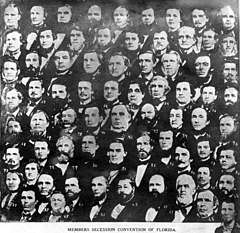
Following the election of Lincoln, a special secession convention, formally known as the "Convention of the People of Florida" was called by Governor Madison S. Perry to prepare for secession from the Union.[5][2][6] Delegates were selected in a statewide election, and met in Tallahassee on January 3, 1861.[7][8] Virginia planter and firebrand Edmund Ruffin came to the convention to advocate for secession.[9] Fifty-one of the 69 convention members held slaves in 1860.[10] Just seven of the delegates were born in Florida.[11]
The convention reconvened on January 5. McQueen McIntosh introduced a series of resolutions defining the purpose of the convention and constitutionality of secession.[12] John C. McGehee, who was involved in drafting Florida's original constitution and became a judge, was elected the convention president.[13][14] Leonidas W. Spratt of South Carolina gave an impassioned speech[15] for secession.[16] Edward Bullock of Alabama also spoke to conventioneers.[2] William S. Harris was the convention's secretary.
On January 7, the vote was overwhelmingly in favor of immediate secession, delegates voting sixty-two to seven to withdraw Florida from the Union.[17]

The Ordinance of Secession was introduced for debate on January 8. The debate was over whether to secede right away or to wait and coordinate secession with other states such as Alabama.[18] Outspoken supporters of secession at the conference included Governor Perry and Governor-elect John Milton. Jackson Morton and George Taliaferro Ward attempted to have the ordinance amended so that Florida would not secede before Georgia and Alabama. When Ward signed the Ordinance he stated "When I die, I want it inscribed upon my tombstone that I was the last man to give up the ship."[19]
McGehee stated "At the South and with our people, of course, slavery is the element of all value, and a destruction of that destroys all that is property. This party, now soon to take possession of the powers of government, is sectional, irresponsible to us, and, driven on by an infuriated, fanatical madness that defies all opposition, must inevitably destroy every vestige of right growing out of property in slaves.”[20]
Those opposed to secession included Conservative plantation owner, former Seminole War military commander Richard Keith Call who advocated for restraint and judiciousness.[21] His daughter Ellen Call Long wrote that upon being told of the vote outcome by its supporters, Call raised his cane above his head and told the delegates who came to his house, "And what have you done? You have opened the gates of hell, from which shall flow the curses of the damned, which shall sink you to perdition."[21]
Ordinance of Secession

Secession was declared and a public ceremony held on the east steps of the Florida capitol the following day; an Ordinance of Secession was signed by 65 people.[8][22][5] The secession ordinance of Florida simply declared its severing of ties with the federal Union, without stating any causes.[23] According to historian William C. Davis, "protection of slavery" was "the explicit reason" for Florida's declaring of secession, as well as the creation of the Confederacy itself.[24] Supporters of secession included the St. Augustine Examiner.[25] Word of the outcome in favor of secession was met with celebrations in Tampa.. The governors of Georgia and Mississippi sent telegrams affirming support for immediate secession.[9]
Afterward, the Florida secession convention formed a committee to draft a declaration of causes, but the committee was discharged before completion of the task.[26] Only an undated, untitled draft remains.[27]
The delegates adopted a new state constitution and within a month the state joined other southern states to form the Confederate States of America.[17] Florida was the third state to secede.[17] By the following month six states had seceded;[28] the first six states to secede had the largest population of slaves among the Southern states. Senator Mallory was part of the first Confederate cabinet, as Secretary of the Navy.
The convention had further meetings in 1861 and into 1862. There was a Unionist minority in the state, an element that grew as the war progressed.
Florida sent a three-man delegation to the 1861-62 Provisional Confederate Congress, which first met in Montgomery, Alabama, and then in the new capital of Richmond, Virginia. The delegation consisted of Jackson Morton, James Byeram Owens, and James Patton Anderson, who resigned April 8, 1861, and was replaced by G. T. Ward. Ward served from May 1861 until February 1862, when he resigned and was replaced by John Pease Sanderson, the namesake of Sanderson.
List of delegates
| Name | County | Secession Vote | Notes |
|---|---|---|---|
| John C. McGehee | Madison | Yes | |
| William S. Harris | Marion | From Ocala, fought in Third Seminole War. | |
| James B. Dawkins | Alachua | Circuit judge of Suwanee Court | |
| John C. Pelot | Alachua | ||
| William B. Yates | Brevard | A minister and veteran of the Seminole Wars. | |
| Simmons J. Baker | Calhoun | Son of Simmons Jones Baker | |
| McQueen McIntosh | Calhoun | ||
| Thomas J. Hendricks | Clay | ||
| Green H. Hunter | Columbia | ||
| Arthur J. T. Wright | Columbia | Merchant. | |
| Asa F. Tift | Dade | Replaced Judge Marvin. | |
| J.M. Daniel | Duval | ||
| John P. Sanderson | Duval | ||
| A. William Nicholson | Escambia | ||
| S. H. Wright | Escambia | ||
| Samuel W. Spencer | Franklin | ||
| Samuel B. Stephens | Franklin | A lawyer whose house still stands.[29] | |
| Abraham K. Allison | Gadsden | ||
| Thomas Y. Henry | Gadsden | ||
| E. C. Love | Gadsden | A planter, lawyer, judge, and mayor of Quincy.[29] | |
| Lewis A. Folsom | Hamilton | ||
| Joseph Thomas | Hamilton | ||
| Benjamin W. Saxon | Hernando | ||
| James Gettis | Hillsborough | Yes | Second lawyer in Tampa, owned no slaves |
| Simon Turman† | Hillsborough | Circuit judge and editor of Florida Peninsular newspaper. | |
| Robert R. Golden | Holmes | ||
| S.S. Alderman | Jackson | ||
| James L.G. Baker | Jackson | ||
| Joseph A. Collier | Jackson | Owner of 34 slaves.[30] | |
| Adam McNealy | Jackson | A planter. | |
| James Patton Anderson | Jefferson | ||
| William S. Dilworth | Jefferson | ||
| Thompson Bird Lamar† | Jefferson | A wealthy physician and planter. | |
| Thomas M. Palmer | Jefferson | ||
| E.P. Barronton | Lafayette | ||
| John Beard | Leon | ||
| W. G. M. Davis | Leon | ||
| James Kirksey | Leon | James Kirksey Plantation | |
| G. W. Parkhill | Leon | ||
| G. T. Ward† | Leon | Owned 3 plantations, and 160 slaves. | |
| George Helvenston | Levy | ||
| William T. Gregory† | Liberty | ||
| Andrew J. Lea | Madison | ||
| Ezekiel Glazier | Manatee | Early settler of Bradenton, designed the Old Manatee County Courthouse. | |
| Summerfield M.G. Gary | Marion | ||
| John J. Lamb | Marion | ||
| William McGahagin | Marion | ||
| James B. Owens | Marion | ||
| Winer Bethel | Monroe-Dade | Yes | Judge in Key West. |
| William Pinckney | Monroe | ||
| James G. Cooper | Nassau | ||
| Joseph Finegan | Nassau | ||
| Isaac S. Coon | New River[n 2] | Cooperationist physician. | |
| Isaac N. Rutland | Orange | No | |
| William W. Woodruff | Orange | No | |
| James O. Devall | Putnam | ||
| Rhydon G. Mays | St. Johns | Owned a large cotton plantation with 82 slaves. | |
| Mathew Solana | St. Johns | Owner of 30 slaves[25] | |
| Jackson Morton | Santa Rosa | ||
| C. C. Simpson | Santa Rosa | ||
| David G. Leigh | Sumter | Yes | |
| James A. Newman | Suwanee | County Commissioner | |
| William H. Sever | Taylor | Yes | |
| James H. Chandler | Volusia | Methodist minister, county judge and treasurer.[31] | |
| Daniel Ladd | Wakulla | ||
| David Lewis | Wakulla | ||
| Alexander L. McCaskill | Walton | No | |
| John Morrison | Walton | No | |
| Freeman B. Irwin | Washington | ||
| Daniel D. McLean† | Washington |
† = Civil War casualty
Civil War
Blockade

As Florida was an important supply route for the Confederate army, Union forces operated a blockade around the entire state. The 8,436-mile coastline and 11,000 miles of rivers, streams, and waterways proved a haven for blockade runners and a daunting task for patrols by Federal warships.
Governor John Milton, an ardent secessionist, throughout the war stressed the importance of Florida as a supplier of goods, rather than personnel. Florida was a large provider of food (particularly beef cattle) and salt for the Confederate Army.
Union troops occupied major ports such as Apalachicola, Cedar Key, Jacksonville, Key West, and Pensacola early in the war. USS Hatteras had blockade duty in Apalachicola, and, in January 1862, was part of a Union naval force which landed in Cedar Key and burned several ships, a pier, and flatcars.[32]
Slaves during the war
Confederate authorities used slaves as teamsters to transport supplies and as laborers in salt works and fisheries. Many Florida slaves working in these coastal industries escaped to the relative safety of Union-controlled enclaves during the war. Beginning in 1862, Union military activity in East and West Florida encouraged slaves in plantation areas to flee their owners in search of freedom. Planter fears of slave uprisings increased as the war went on.[33]
Some worked on Union ships and, beginning in 1863, more than a thousand enlisted as soldiers in the United States Colored Troops or as sailors in the Union Navy.[34] Escaped and freed slaves provided Union commanders with valuable intelligence about Confederate troop movements. They also passed back news of Union advances to the men and women who remained enslaved in Confederate-controlled Florida.
In January 1865, Union General William T. Sherman issued Special Field Orders No. 15 that set aside a portion of Florida as designated territory for runaway and freed former slaves who had accompanied his command during its March to the Sea. These controversial orders were not enforced in Florida, and were later revoked by President Andrew Johnson.
Deserters
Growing public dissatisfaction with Confederate conscription and impressment policies encouraged desertion by Confederate soldiers. Several Florida counties became havens for Florida deserters, as well as deserters from other Confederate states. Deserter bands attacked Confederate patrols, launched raids on plantations, confiscated slaves, stole cattle, and provided intelligence to Union army units and naval blockaders. Although most deserters formed their own raiding bands or simply tried to remain free from Confederate authorities, other deserters and Unionist Floridians joined regular Federal units for military service in Florida.[33]
Battles
Overall, the state raised some 15,000 troops for the Confederacy, which were organized into twelve regiments of infantry and two of cavalry, as well as several artillery batteries and supporting units. The state's small population (140,000 residents making it last in size in the Confederacy), relatively remote location, and meager industry limited its overall strategic importance. The battles in Florida are mostly numerous small skirmishes, as neither army aggressively sought control of the state.
Forts
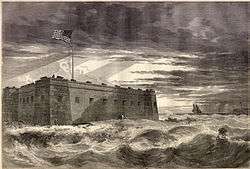
Governor Milton also worked to strengthen the state militia and to improve fortifications and key defensive positions. Confederate forces moved quickly to seize control of many of Florida's U.S. Army forts, succeeding in most cases, with the significant exceptions of Fort Jefferson, Fort Pickens and Fort Zachary Taylor, which stayed firmly in Federal control throughout the war.
_(14762345812).jpg)
On January 10, 1861, the day Florida declared its secession from the Union, Adam J. Slemmer destroyed over 20,000 pounds (9,100 kg) of gunpowder at Fort McRee. He then spiked the guns at Fort Barrancas, and moved his force to Fort Pickens. Braxton Bragg commanded the Battle of Pensacola.
On October 9, Confederates, including the 1st Florida Infantry, commanded by convention delegate James Patton Anderson, tried to take the fort at the Battle of Santa Rosa Island.[35] They were unsuccessful, and Harvey Brown planned a counter. On November 22, all Union guns at Fort Pickens, and two ships, Niagara and Richmond, targeted Fort McRee.[36]
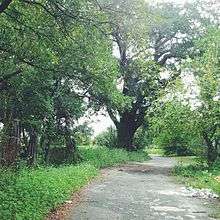
On January 1, there was an artillery duel in Pensacola. 28 gunboats commanded by Commodore Samuel Dupont occupied Fort Clinch at Fernandina Beach in March 1862. On March 11, the Union captured St. Augustine and Fort Marion.
Skirmish of the Brick Church
The first land engagement in Northeast Florida and first Confederate victory in Florida was the Skirmish of the Brick Church, fought by the 3rd Florida Infantry, commanded by convention delegate Col. William S. Dilworth.[37] Delegate Arthur J.T. Wright was an officer.[38]
Eastern Theater
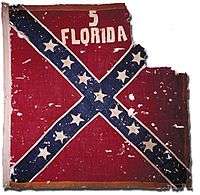
As a result of Florida's limited strategic importance, the 2nd, 5th, and 8th Florida Infantries were sent to serve in the Eastern Theater in Robert E. Lee's Army of Northern Virginia. They fought at Second Manassas, Antietam, Fredericksburg, Chancellorsville and Gettysburg.

The 2nd Florida Infantry was first commanded by convention delegate G. T. Ward. He participated in the Yorktown siege, and died after being shot at the Battle of Williamsburg, the first battle of the Peninsula Campaign.
Richard K. Call's son-in-law Theodore W. Brevard Jr. was captain of the 2nd's Company D, the "Leon Rifles" at Yorktown and Williamsburg, leaving shortly afterwards. Francis P. Fleming was a private in the 2nd. Convention delegate Thomas M. Palmer was the 2nd's surgeon.[39]
Roger A. Pryor commanded the 2nd during the Seven Days Battles. After Second Manassas, Pryor wrote “The Second, Fifth and Eighth (Florida) Regiments, though never under fire, exhibited the cool and collected courage of veterans."[40]
Delegate Andrew J. Lea was captain of the 5th's Company D. Delegates Thompson Bird Lamar and William T. Gregory served with the 5th at Antietam. Lamar was wounded and Gregory was killed.[41]
Perry's Florida Brigade

After Antietam, the 2nd, 5th, and 8th were grouped together under Brig. Gen. Edward A. Perry. Perry's Florida Brigade served in Anderson’s Division of the First Corps under Lt. Gen. James Longstreet.[42]
At Fredericksburg, the 8th regiment, whose Company C was commanded by David Lang protected the city from General Ambrose Burnside, contesting Federal attempts to lay pontoon bridges across the Rappahannock River. An artillery shell fragment struck the chimney of the building that Lang occupied, and a large chunk of masonry struck him in the head, gravely injuring him. He was promoted to commander of the 8th.
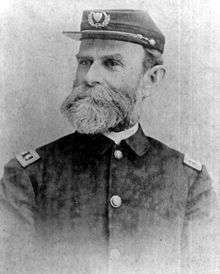
After Chancellorsville, Perry was stricken with typhoid fever. Perry wrote "The firm and steadfast courage exhibited, especially by the Fifth and Second Florida Regiments, in the charge at Chancellorsville, attracted my attention."[40]
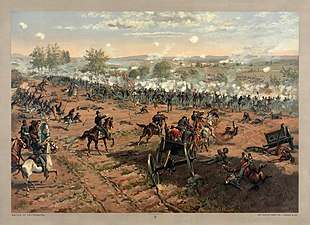
Lang took command of the Florida Brigade. The Florida Brigade served through the Gettysburg Campaign and twice charged Cemetery Ridge at Gettysburg, including supporting Pickett's Charge. It suffered heavy fire from Lt. Col. Freeman McGilvery's line of artillery, and lost about 60% of its 700 plus soldiers when attacked on one flank by the 2nd Vermont Brigade of Brig. Gen. George J. Stannard.
Perry then returned to command of the Florida Brigade, leading it in the Bristoe and Mine Run campaigns.
Western Theater

In early 1862, the Confederate government pulled General Bragg's small army from Pensacola following successive Confederate defeats in Tennessee at Fort Donelson and Fort Henry and the fall of New Orleans. It sent them to the Western Theater for the remainder of the war. Florida native Edmund Kirby Smith fought with Bragg.
The 1st and 3rd Florida Infantry Regiments joined Bragg in Tennessee. Convention delegate W. G. M. Davis raised the 1st Florida Cavalry and joined General Joseph E. Johnston in Tennessee. In December 1863, the 4th Florida Infantry was consolidated with the 1st Cavalry. Convention delegate Daniel D. McLean was a 2nd lieutenant in the 4th's Company H, and died in service. The 7th Florida Infantry also fought with the Army of Tennessee.
Battles in Florida
After Bragg's troops left for Tennessee, the only Confederate forces remaining in Florida at that time were a variety of independent companies, several infantry battalions, and the 2nd Florida Cavalry, commanded by J. J. Dickison. On May 20, Confederates ambushed a Union landing party in Crooked River.
Tampa
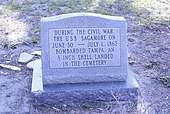
The Union gunboat USS Sagamore sailed up Tampa Bay to bombard Fort Brooke under the command of John William Pearson. The Battle of Tampa was inconclusive, as the shells fell ineffectually and there were no casualties on either side.[43] Convention delegate James Gettis was singled out for bravery while manning the cannons.
St. Johns Bluff
Jacksonville was occupied after the Battle of St. Johns Bluff, a bluff designed to stop the movement of Federal ships up the St. Johns River,[44] was won by John Milton Brannan and about 1,500 infantry.

The flotilla arrived at the mouth of the St. John' s River on October 1, where Cdr. Charles Steedman' s gunboats—Paul Jones, Cimarron, Uncas, Patroon, Hale, and Water Witch—joined them. Brannan landed troops at Mayport Mills. The Bluff held off the Naval squadron until the troops were landed to come up behind it, the Confederates quietly abandoned the work.
In January 1863, there was a skirmish at Township Landing with the 1st South Carolina Volunteer Infantry. On March 9, 1863, 80 Confederates were driven off by 120 men of the 7th New Hampshire Volunteers near St. Augustine.
On 28 July 1863, Sagamore and USS Para attacked New Smyrna.
Fort Brooke
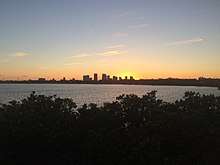
The second battle in Tampa occurred in October 1863 with the Battle of Fort Brooke.[45] Two Union Navy ships, USS Tahoma and USS Adela, bombarded the fort. Two days later, the Battle of Ballast Point took place.[46] Near modern-day Lowry Park Zoo, the Union troops surprised, captured, and burned two of James McKay's notorious ships, the blockade runner Scottish Chief, a steamship, and the sloop Kate Dale a few miles up the river. Escaping capture by mere minutes, with members of his crew in tow, McKay sped to the city of Tampa and warned all of the landing party and the fate of his ships. McKay Bay is named for him.
Final years
The force remaining in Florida were reinforced in 1864 by troops from neighboring Georgia. Andersonville Prison began in February 1864. Convention delegate John C. Pelot was its lead surgeon.
Olustee
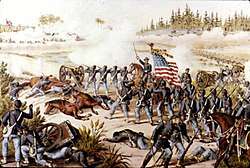
Quincy Gillmore selected Truman Seymour for an invasion of Florida, landing in Jacksonville on February 7.[47] Joseph Finegan skirmished with Union forces at Barber's Ford and Lake City on February 10 and 11.[48] The only major engagement in Florida was at Olustee near Lake City.[49] Union forces under Seymour were repulsed by Finegan's Florida and Georgia troops and retreated to their fortifications around Jacksonville. Brevard's Battalion fought with Finegan's Brigade at Olustee.
.jpg)
Seymour's relatively high losses caused Northern lawmakers and citizens to question the necessity of any further Union actions in militarily insignificant Florida. Many of the Federal troops were withdrawn and sent elsewhere. Throughout the balance of 1864 and into the following spring, the 2nd Florida Cavalry repeatedly thwarted Federal raiding parties into the Confederate-held northern and central portions of the state.
The Skirmish at Cedar Creek soon followed.[50] Perry had suffered wounds, and the three regiments of Perry's Brigade were consolidated into Finegan's Brigade, which included the 9th, 10th and 11th Infantries. Convention delegate Green H. Hunter was captain of the 9th's Company E. There was a skirmish at McGirt's Creek on March 1, 1864.
In March 1864, McKay wrote the state to say he was unable to secure cattle. C. J. Munnerlyn organized the 1st Florida Special Cavalry Battalion or "Cow Cavalry" in April made up of Florida crackers, including John T. Lesley, Francis A. Hendry and W. B. Henderson.[51]
Horse Landing
Convention delegate James O. Devall owned General Sumpter, the first steamboat in Palatka, which was captured by USS Columbine in March 1864.[52] Palatka was occupied, and there were two picket attacks in late March. Union troops utilized Sunny Point, and St. Mark's was used as a barracks.
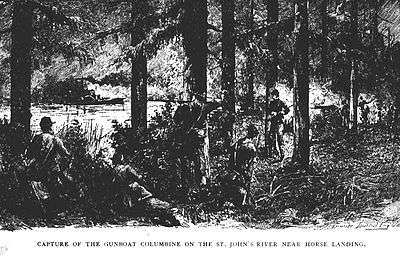
The first mine casualty of the war was Maple Leaf at Jacksonville on April 1, 1864.[53] General Hunter was sunk on April 16, close to where Maple Leaf was sunk.[54]
On May 19, there was a skirmish with the 17th Connecticut in Welaka, and a skirmish in Saunders. On May 21, spy Lola Sanchez got wind of a Union raid, and the Columbine was captured by Dickison's forces at the "Battle of Horse Landing".
New York's 14th cavalry lost in a skirmish at Cow Ford Creek on April 2. The 7th United States Colored Infantry fought in a skirmish at Camp Finnegan on May 25, and on the same day there was a skirmish at Jackson's Bridge near Pensacola.

Camp Milton was captured on June 2, and Baldwin raided on July 23. The Union would raid Florida's cattle. A skirmish at Trout Creek occurred on July 15. On July 24, William Birney was attacked by G. W. Scott and the 2nd Florida Cavalry at the South Fork of Black Creek.[55]
The Florida Brigade took part in the Overland Campaign. Perry was wounded at the Battle of the Wilderness. The Brigade was then at the Battle of Cold Harbor. Afterwards, the 11th was reorganized with Brevard as commander.
The Brigade then fought at the Siege of Petersburg. At Weldon Railroad, Brevard learned of the death of his brother, Mays Brevard. The Brigade also fought at the Battle of Ream's Station and the Battle of Globe Tavern. Lamar was shot off his horse by a Yankee sniper at Petersburg on August 30.[56]
Gainesville
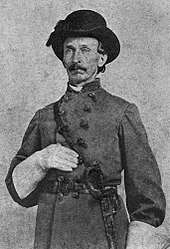
Confederates occupied Gainesville after the Battle of Gainesville.[57] On August 15, 1864 Col. Andrew L. Harris of the 75th Ohio Mounted infantry left Baldwin with 173 officers and men from the Seventy-Fifth Ohio Volunteer Infantry. The Union troops on the way destroyed a picket post on the New River. At Starke, the Union troops were joined by the 4th Massachusetts Cavalry and some Florida Unionists.[58] On August 17, 1864, Dickison was told that members of the Union Army had arrived at Starke and that they had burned Confederate train cars. Dickison proceeded to Gainesville, and attacked the Union troops from the rear.
Marianna
On September 27, 1864, General Alexander Asboth led a raid in Marianna, the home of Governor Milton and an important supply depot, and a battle ensued, with the Union stunned at first but achieving a victory.[59] Convention delegate Adam McNealy served in the Marianna Home Guard. Asboth was wounded, as was dentist Thaddeus Hentz, not far from his mother's grave, the famed novelist Caroline Lee Hentz, who wrote The Planter's Northern Bride, a pro-slavery rebuttal to Harriet Beecher Stowe's popular anti-slavery book, Uncle Tom's Cabin. The next day, Asboth's forces again ran into a battle in Vernon.

On October 18 at Pierce's Point south of Milton, Union troops were attacked by Confederates. In December 1864, there were skirmishes in Mitchell's Creek and Pine Barren Ford with the 82nd Colored Infantry.[60]
Braddock's Farm
Near Crescent City, there was the Battle of Braddock's Farm. Dickison caught the troops of the 17th Connecticut Infantry when they had just finished a raid, and when they charged, he shot their commander Albert Wilcoxson off his horse. When Dickison asked Wilcoxson why he charged, he responded, "Don't blame yourself, you are only doing your duty as a soldier. I alone am to blame."[61]
In Cedar Key, there was the Battle of Station Four.[62] The Battle of Fort Myers is known as the "southernmost land battle of the Civil War."[63] Confederate Maj. William Footman led 275 men of the "Cow Cavalry" to the fort under a flag of truce to demand surrender. The fort's commander, Capt. James Doyle, refused, and the battle began.
Natural Bridge

In March 1865 Battle of Natural Bridge, a small band of Confederate troops and volunteers, mostly composed of teenagers from the nearby Florida Military and Collegiate Institute that would later become Florida State University, and the elderly, protected by breastworks, prevented a detachment of United States Colored Troops from crossing the Natural Bridge on the St. Marks River.[64]
Brevard took command of the Florida Brigade on March 22.
On April 1, Governor Milton committed suicide rather than submit to Union occupation.[65] In a final statement to the state legislature, he said Yankees "have developed a character so odious that death would be preferable to reunion with them." He was replaced by convention delegate Abraham K. Allison.
Brevard was captured at the Battle of Sailor's Creek by General George Custer's cavalry.[66]
Surrender and immediate aftermath
Lang was again leading the Florida Brigade when it surrendered at Appomattox Court House on April 9, 1865. Johnston surrendered at Bennett Place on April 26, ending the war for the 89,270 soldiers in North Carolina, South Carolina, Georgia, and Florida.
In early May 1865, Edward M. McCook's Union division was assigned to re-establish Federal control and authority in Florida. On May 13, G.W. Scott surrendered the last active Confederate troops in the state to McCook.
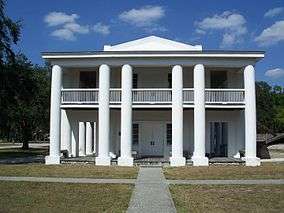
On May 20, General McCook read Lincoln's Emancipation Proclamation during a ceremony in Tallahassee, officially ending slavery in Florida. That same day, his jubilant troopers raised the U.S. flag over the state capitol building. Tallahassee was the penultimate Confederate state capital to rejoin the Union. Austin, Texas rejoined the next month.
Yulee was imprisoned for helping Jefferson Davis escape, and Lesley hid Judah Benjamin in a swamp before he fled to the Gamble Mansion.
Following the end of the Civil War, Florida was part of the Third Military District.[67]
Restoration to Union
After meeting the requirements of Reconstruction, including ratifying amendments to the US Constitution to abolish slavery and grant citizenship to former slaves, Florida's representatives were readmitted to Congress. The state was fully restored to the United States on June 25, 1868. Convention delegate E.C. Love was a leader in restoring the Democratic Party in Florida.[n 3]
As part of the Compromise of 1877, in which Southern Democrats would acknowledge Republican Rutherford B. Hayes as president, had the understanding that Republicans would meet certain demands. One affecting Florida was the removal of all US military forces from the former Confederate states.[68] At the time, US troops remained in only Louisiana, South Carolina, and Florida, but the Compromise completed their withdrawal from the region.
Notes
- The Muscogee (Creeks) and other Indians were classified below the free people of color and above slaves.[1]
- Now Bradford County
- His house still stands.[29]
References
- Jane E. Dysart, "Another Road to Disappearance: Assimilation of Creek Indians in Pensacola, Florida during the Nineteenth Century", The Florida Historical Quarterly, Vol. 61, No. 1 (July 1982), pp. 37-48, published by Florida Historical Society accessed 26 June 2014
- Wooster, Ralph A. (1958). "The Florida Secession Convention". The Florida Historical Quarterly. 36 (4): 373–385. JSTOR 30139845.
- Hindley, Meredith (November–December 2010). "The Man Who Came in Second". Humanities. 31 (6). Retrieved March 13, 2020.
- "Publications of the Florida Historical Society". Florida Historical Society. December 28, 2018 – via Google Books.
- Florida, State Library and Archives of. "Ordinance of Secession, 1861". Florida Memory.
- "Florida Secession Convention (1861-1862) (Florida. Secession Convention (1861-1862)) - The Online Books Page". onlinebooks.library.upenn.edu.
- Weitz, Seth A.; Sheppard, Jonathan C. (June 12, 2018). A Forgotten Front: Florida During the Civil War Era. University of Alabama Press. ISBN 9780817319823 – via Google Books.
- "Ordinance of Secession, 1861". Florida Department of State. Retrieved June 20, 2018.
- Wynne, Nick; Knetsch, Joe (August 31, 2015). On This Day in Florida Civil War History. Arcadia Publishing. ISBN 9781625856111 – via Google Books.
- Wooster, Ralph A. (1958). "The Florida Secession Convention". The Florida Historical Quarterly. 36 (4): 373–385. JSTOR 30139845.
- Florida, State Library and Archives of. "Civil War". Florida Memory.
- https://stars.library.ucf.edu/cgi/viewcontent.cgi?referer=&httpsredir=1&article=3221&context=etd
- "Freedom First". February 2, 2006. Archived from the original on February 2, 2006.
- admin (February 18, 2016). "History of John C. McGehee".
- Underwood, Rodman L. (January 1, 2005). Stephen Russell Mallory: A Biography of the Confederate Navy Secretary and United States Senator. McFarland. ISBN 9780786422999 – via Google Books.
- "Los Angeles Herald 5 October 1903 — California Digital Newspaper Collection". cdnc.ucr.edu.
- "Museum of Florida History - Florida Secedes from the Union » Florida in the Civil War". www.museumoffloridahistory.com. Archived from the original on January 1, 2019. Retrieved January 1, 2019.
- Barnhardt, Luther Wesley (1922). "The Secession Conventions of the Cotton South". University of Wisconsin--Madison – via Google Books.
- Florida, State Library and Archives of. "Presentation of Confederate Battleflag to Family of Colonel George T. Ward, 1862". Florida Memory.
- "Archived copy" (PDF). Archived from the original (PDF) on January 1, 2019. Retrieved January 1, 2019.CS1 maint: archived copy as title (link)
- Josh. "Richard Keith Call Collection Now Online at Florida Memory". Archived from the original on April 25, 2014.
- "Florida Ordinance of Secession". 1starnet.com. Archived from the original on October 12, 2007. Retrieved June 20, 2018.
- "Ordinance of secession". Ufdc.ufl.edu. Retrieved April 19, 2014.
- Davis, William C. (2002). "Men but Not Brothers". Look Away!: A History of the Confederate States of America. pp. 130–135. ISBN 9780743227711. Retrieved May 25, 2016.
- Redd, Robert (February 11, 2014). St. Augustine and the Civil War. Arcadia Publishing. ISBN 9781625846570 – via Google Books.
- "Florida Declaration-More information". www.civilwarcauses.org.
- "Florida Declaration". www.civilwarcauses.org.
- "Today in History - January 10". Library of Congress, Washington, D.C. 20540 USA.
- admin (October 20, 2015). "HISTORIC HOMES". dosomethingoriginal.com. Archived from the original on January 1, 2019. Retrieved January 1, 2019.
- "Slavery and plantation growth in Antebellum Florida, 1821-1860". ufdc.ufl.edu.
- "Historic Graveyards - River of Lakes Heritage Corridor". riveroflakesheritagecorridor.org.
- "Civil War Raids & Skirmishes in 1862". www.mycivilwar.com.
- Murphree (2008)
- Murphree, R. Boyd. "Florida and the Civil War: A Short History" Archived 2010-04-26 at the Wayback Machine, State Archives of Florida. Retrieved on June 5, 2008.
- October 9, 1861
- "Pensacola - Early Civil War Union Victory". exploringoffthebeatenpath.com.
- "Lost Church, Lost Battlefield, Lost Cemetery, Lost War - Metro Jacksonville". www.metrojacksonville.com.
- Sheppard, Jonathan C. (May 11, 2012). By the Noble Daring of Her Sons: The Florida Brigade of the Army of Tennessee. University of Alabama Press. ISBN 9780817317072 – via Google Books.
- "Palmer Family Graveyard and Palmer-Perkins House in Monticello, FL". Visit Florida.
- "Museum of Southern History_Floridians in Virginia".
- "Antietam: Capt William T. Gregory". antietam.aotw.org.
- Hawk, Robert. Florida's Army: Militia/State Troops/National Guard 1565-1985. Englewood, FL: Pineapple Press Inc. 1986. Pg 96.
- Other Name: 'Yankee Outrage at Tampa.' June 30-July 1, 1862
- October 1–3, 1862
- "Florida Battle at Fort Brooke American Civil War". www.americancivilwar.com.
- "The Battle of Ballast Point, fought on October 18, 1863 at Ballast Point, Tampa, Florida, was considered a continuation of The Battle of Fort Brooke". Retrieved April 1, 2014.
- "Battle of Olustee - Events Leading up to the Battle of Olustee". battleofolustee.org.
- Hewitt, Lawrence L.; Bergeron, Arthur W. (May 30, 2011). Confederate Generals in the Western Theater, Vol. 3: Essays on America's Civil War. Univ. of Tennessee Press. ISBN 9781572337909 – via Google Books.
- "Battle of Olustee Facts & Summary". American Battlefield Trust. January 13, 2009.
- "The Museum of Southern History". March 3, 2009. Archived from the original on March 3, 2009.
- Taylor, Robert A. (1986). "Cow Cavalry: Munnerlyn's Battalion in Florida, 1864-1865". The Florida Historical Quarterly. 65 (2): 196–214. JSTOR 30146741.
- Rob, Seaman (April 6, 2014). "Civil War Navy Sesquicentennial: Sinking of the Union transport steamer Maple Leaf".
- "Archived copy". Archived from the original on July 24, 2014. Retrieved April 23, 2014.CS1 maint: archived copy as title (link)
- "Antietam: LCol Thompson Bird Lamar". antietam.aotw.org.
- "Gainesville, Florida Civil War site photos". www.civilwaralbum.com. Archived from the original on June 24, 2013. Retrieved November 10, 2013.
- "The Battle of Gainesville". exploresouthernhistory.com. Retrieved November 24, 2017.
- The Battle of Marianna Archived 2013-11-10 at the Wayback Machine
- "Florida Battles - The Civil War (U.S. National Park Service)". www.nps.gov.
- "Archived copy". Archived from the original on November 10, 2013. Retrieved November 10, 2013.CS1 maint: archived copy as title (link)
- "Cedar Key, Florida Civil War site photos". www.civilwaralbum.com. Archived from the original on September 23, 2015. Retrieved January 4, 2019.
- "Battle of Fort Myers, FL site photos". www.civilwaralbum.com. Archived from the original on November 22, 2013. Retrieved November 10, 2013.
- "Battle of Natural Bridge Facts & Summary". American Battlefield Trust. December 19, 2008.
- "Florida Governor John Milton". National Governors Association. Archived from the original on December 9, 2009. Retrieved June 1, 2009.
- Dickinson, J.J. (1899). "Military History of Florida" (PDF). In Evans, Cement Anslem (ed.). Confederate military history; a library of Confederate States history. 11. Atlanta: Confederate Publishing Co. p. 160.
- Cox, Merlin (January 1968). "Military Reconstruction in Florida". Florida Historical Quarterly. 46 (3): 219.
- Woodward, C. Vann (1966). Reunion and Reaction: The Compromise of 1877 and the End of Reconstruction. Boston: Little, Brown and Company. pp. 169–171.
Further reading
- Brown, Canter. Tampa in Civil War & Reconstruction, University of Tampa Press, 2000. ISBN 978-1-879852-68-6.
- Eicher, John H., and Eicher, David J., Civil War High Commands, Stanford University Press, 2001, ISBN 0-8047-3641-3.
- Johns, John Edwin. Florida During the Civil War (University of Florida Press, 1963)
- Murphree, R. Boyd. "Florida and the Civil War: A Short History" State Archives of Florida.
- Nulty, William H. Confederate Florida: The Road to Olustee (University of Alabama Press, 1994)
- Revels, Tracy J. Florida's Civil War: Terrible Sacrifices (Mercer University Press, 2016). xx, 197 pp
- Taylor, Paul. Discovering the Civil War in Florida: A Reader and Guide (2nd edition). Sarasota, Fl. Pineapple Press, 2012. ISBN 978-1-56164-529-9
- U.S. War Department, The War of the Rebellion: A Compilation of the Official Records of the Union and Confederate Armies, 70 volumes in 4 series. Washington, D.C.: United States Government Printing Office, 1880-1901.
External links
| Wikimedia Commons has media related to Florida in the American Civil War. |
- Cannonball at A History of Central Florida Podcast
- Florida and the Civil War, open access digital collection of materials from the PK Yonge Library of Florida History
- Florida Memory Project - State Archives
- National Park Service map of Civil War sites in Florida
| Preceded by South Carolina |
List of C.S. states by date of admission to the Confederacy Ratified Constitution on April 22, 1861 (7th) |
Succeeded by Virginia |
.svg.png)

